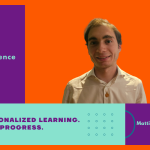Drivingo was born from a simple question with a powerful implication: how do Deaf or non-verbal people order at a drive-thru? For founder Levern Currie, discovering the lack of accessibility led to a bigger mission. Today, Drivingo is building AI-powered, speech-independent ordering systems that make fast food truly inclusive.
1. What inspired the creation of Drivingo, and what problem were you aiming to solve?
Levern Currie: Drivingo was inspired by a moment of realization, I didn’t know how Deaf or hard-of-hearing (HOH) people ordered at the drive-thru. And when I investigated it, what I found was disheartening. There wasn’t just a lack of accommodation, there were countless stories of mistreatment. People being berated, ignored, or even denied service simply because they couldn’t hear or speak in the way the system expected them to.
This wasn’t just a gap in service. It was a human rights issue. I wondered: Why hasn’t anyone fixed this yet? This became the starting point for Drivingo.
Drivingo was built to restore dignity, independence, and access to a system that had excluded many people for far too long. I knew I could design and build technology that understood gestures and natural language and wanted to bring that to the world. So, I did.
2. How does Drivingo address accessibility challenges in the quick-service restaurant industry?
Levern Currie: Drivingo tackles accessibility challenges by fundamentally redesigning how people interact with ordering. The traditional model relies entirely on spoken communication, which leaves out a lot of people, Deaf and hard-of-hearing individuals, non-verbal customers, people with speech impairments, autistic individuals and even non-native English speakers.
We’ve revolutionized proprietary gesture recognition technology and enhanced natural language processing for customer service interactions. For example, someone who’s Deaf can use hand gestures to place their order, completely bypassing the need for verbal communication. Enhanced UI and UX make our system intuitive and bespoke. In addition, we’ve enhanced customizable language options for real-time translation to support everyone.
In addition, we’ve also reduced cognitive load by simplifying the ordering flow, making it an easier and stress-free experience. Lastly, we’ve prioritized privacy, our system lets people order independently, without needing to explain themselves or rely on external assistance. At its core, Drivingo isn’t just about making fast food faster, it’s about making it more inclusive and accessible for everyone.
3. What were the biggest obstacles in developing a speech-independent ordering system?
Levern Currie: One of our biggest challenges was reimagining an ordering system that didn’t rely on speech or physical input at all. Most systems in the quick-service space are built with the assumption that the customer will speak or touch their interface, and that creates huge accessibility and usability barriers. So, stepping away from these standards meant we had to rethink everything: how orders are initiated, how choices are presented, and how confirmation happens, all without relying on audio and touch cues.
Technically, gesture recognition in a real-world environment is tough. You’re dealing with changing lighting, weather conditions, reflections, and movement. The system must be both precise and reliable enough to understand intentional gestures and background noise – while still working fast enough for fast paced and high-throughput environments.
4. How has your experience in the Techstars Equitech Accelerator influenced Drivingo’s growth?
Levern Currie: Techstars Equitech was a game-changer for Drivingo. We came in with a clear vision and a working prototype, however, the program pushed us to think bigger, not just about what we were building, but who we were building it for, and how we would scale it sustainably and equitably.
One of the most impactful parts was the focus on inclusive innovation. Equitech isn’t just about diversity on paper, it’s about embedding equity into the DNA of your company. That aligned perfectly with Drivingo’s mission. It gave us the language and the strategy to position accessibility not as a “feature,” but as a core driver of business value and impact. In addition, being in a cohort of other founders who were mission-driven, created a level of accountability and inspiration that really pushed us forward.
But honestly, the biggest thing Techstars gave us was confidence, confidence in our story, in the depth of the problem we’re solving, and in the fact that building an inclusive product is building a competitive product. It helped us sharpen our pitch, tighten our operations, and prepare for the kind of scale and visibility that Drivingo is headed toward.
5. Can you explain how Drivingo’s machine learning-based ordering system works?
Levern Currie: Absolutely. Drivingo’s ordering system uses a combination of computer vision, natural language processing, and machine learning models to create a seamless, speech-independent ordering experience.
Here’s how it works:
When a customer approaches the kiosk or drive-thru, they can choose to use Drivingo’s gesture voice or touch input. In the case of gesture, Drivingo activates a gesture recognition system powered by computer vision to interpret hand signs in real time; mapping them to menu items. The dataset we made, is trained on diverse users, allowing it to detect variations in skin tone, lighting, and signing speed, it ensures broad accessibility. Simultaneously, for those who prefer typing or speaking, our voice engine interprets casual or non-standard phrasing with precision—for example, turning “just a plain burger, no cheese or anything” into the correct item and modifiers.
Inputs across all modalities feed into a dynamic recommendation engine that uses machine learning to suggest popular combos, allergen-friendly options, or location-specific specials based on user behavior and context. This loop is not just reactive but predictively transparent and user controlled
6. What makes Drivingo’s gesture recognition technology unique compared to traditional voice-based AI ordering?
Levern Currie: What makes Drivingos gesture ordering unique is that not only has it not been done before, but gesture recognition technology is the future, and we are working on implementing it ubiquitously. Drivingo is the only system that makes gesture recognition the primary input method, not a secondary fallback. Traditional voice AIs assume users can speak clearly, excluding Deaf, non-verbal, and speech-impaired customers. Drivingo reverses this by using computer vision trained on diverse, real-world data to accurately recognize intentional gestures across different skin tones, body types, and lighting conditions—even outdoors.
Unlike voice systems that struggle with accents, noise, or phrasing, Drivingo works silently, intuitively, and inclusively. It’s also natively multimodal, allowing users to switch between gesture, voice, or touch without restarting. And unlike competitors that use humans behind the scenes, Drivingo is fully AI-driven and scalable, fully ready for real-world deployment.
7. How do you see AI-driven automation reshaping customer interactions in QSRs?
Levern Currie: AI-driven automation is going to completely transform how customers interact with quick-service restaurants, not just by making things faster, but by making them smarter, more personalized, and more inclusive.
Right now, most QSR interactions are transactional: you place an order, you pay, you leave. But with AI, we’re moving toward experiences that adapt to each customer in real time. That could mean recognizing returning customers and streamlining their usual orders, adjusting the interface to match their communication preferences, or offering recommendations based on dietary needs, time of day, or even local inventory.
Systems like Drivingo’s can recognize gestures, process natural language, and adjust to the user. That means fewer mistakes, faster throughput, and more independence for customers who’ve traditionally been left out of the equation. Long term, I see AI making QSRs more accessible, adaptive, and human-centered, ironically, by offloading the friction so staff can focus more on the human side of service.
8. What are the main benefits for businesses implementing Drivingo’s technology?
Levern Currie: Drivingo offers businesses a powerful blend of operational efficiency, improved customer experience, and brand differentiation. One of the most immediate benefits is increased order accuracy and speed. Because our system eliminates the common issues that come with verbal communication like misheard orders or language barriers; restaurants see fewer mistakes, less food waste, and faster service times. That leads directly to higher throughput and better customer satisfaction.
Another major advantage is labor optimization. We allow staff to be reallocated to more meaningful roles like food prep, hospitality, or quality control. In an industry where labor shortages are a constant concern, flexibility is a huge asset. At the same time, Drivingo expands the customer base by making the experience usable to a wider audience. Building loyalty and trust in communities that have been underserved.
9. What have been the biggest challenges in scaling Drivingo, and how did you overcome them?
Levern Currie: One of the biggest challenges in scaling Drivingo has been building for the complexity of the real world, without yet having the benefit of live pilots. Our vision has always been clear: create a drive-thru system that’s fully accessible, inclusive, and speech-independent. But taking that from concept to a scalable, production-ready solution meant anticipating the variability of real environments, things like lighting, weather, customer behavior, and hardware configurations. We’ve had to develop and refine our models in simulation and controlled testing environments, knowing that adaptability and reliability are key once we move into deployment.
We’ve overcome those challenges by staying focused on execution, surrounding ourselves with the right advisors, and leaning into programs like Techstars Equitech that help us clarify our message and strategy. As a result, we are working toward 3 live pilots with our first customers.
10. AI-powered customer service can face ethical and privacy concerns—how does Drivingo ensure security and compliance?
Levern Currie: That’s a good question, and that’s something we take seriously.” Drivingo was designed from the ground up around the principles of inclusion and dignity, and that also carries through in our approach to data and privacy. We design with privacy in mind, first and foremost. We only log the bare minimum of data needed to process an order, and we do not capture or store personally identifiable information unless necessary (e.g., if a user opts as part of the personalization features).
Our models are fully on-prem, minimizing unnecessary data transmission and reducing the chance of exposure. Processed data is stored temporarily, and is encrypted end-to-end, ensuring full anonymity. We will also ensure that we stay compliant with industry regulations, including relevant accessibility and data privacy regulations. Ahead of our deployment, we’re collaborating with legal and compliance experts to ensure that our systems can be responsibly scaled across various jurisdictions.
Beyond compliance, we believe in transparency and consent. Users should always know when they’re interacting with AI, and they should have control over how their data is used. We’re designing Drivingo to respect that from the very first interaction, because we believe that accessibility without ethics isn’t real inclusion.
11. What does success look like for you and Drivingo in the next five years?
Levern Currie: Success, for me, is seeing a world where inclusive design is no longer treated as an afterthought, it’s the standard. In five years, I want Drivingo to be the go-to solution for accessible, automated ordering in the quick-service industry. That means not just having a presence in major fast-food chains but proving that when you build for the edges, for the Deaf community, for non-verbal users, for people with disabilities, you end up creating a better experience for everyone.
I want to see our technology implemented in hundreds, maybe thousands, of customers facing interactions across the country and internationally. I want Drivingo to be the reason someone had their first independent ordering experience or finally felt seen by a brand that had overlooked them for years. But beyond the tech, success also looks like Drivingo becoming a model for what ethical, equity-driven innovation can be. I want to grow a company that centers people, operates with integrity, and proves that accessibility is not only scalable, but also profitable, it’s powerful, and it’s the future.
12. What does a typical day look like for your team, and how do you stay motivated?
Levern Currie: At this stage, we’re early-stage and build-heavy, so a day in the life looks like focused development, strategic planning, and a lot of communication. Mornings usually start with quick syncs, what’s blocking us, what’s moving forward, what needs attention. From there, it’s hands-on: refining our models, testing UI components, researching implementation logistics, or preparing for conversations with potential partners or advisors.
Because we’re building something that doesn’t really exist in the market yet, we stay motivated by coming back to our why. Every day, we’re thinking about the people this is for. That keeps the mission front and center: Making technology that improves others’ lives. And honestly, motivation also comes from seeing how people light up when they hear what we’re doing, especially those who’ve experienced the problem firsthand. That energy keeps us grounded. Even when it’s hard, even when there’s friction, we know the work matters. That’s what drives us.
Editor’s Note
Levern Currie is turning a neglected accessibility gap into a catalyst for systemic change. Drivingo’s gesture-first, multimodal platform is more than a product—it’s a bold rethinking of customer experience. In this interview, he outlines how inclusive design can scale and reshape the quick-service industry.
Discover more interviews with AI founders on the AIPressRoom Interviews page.



